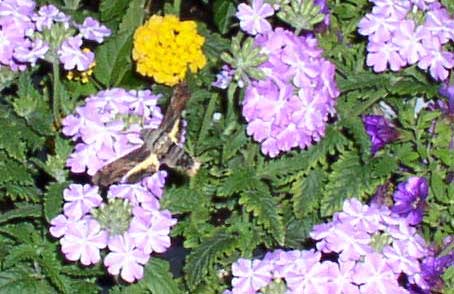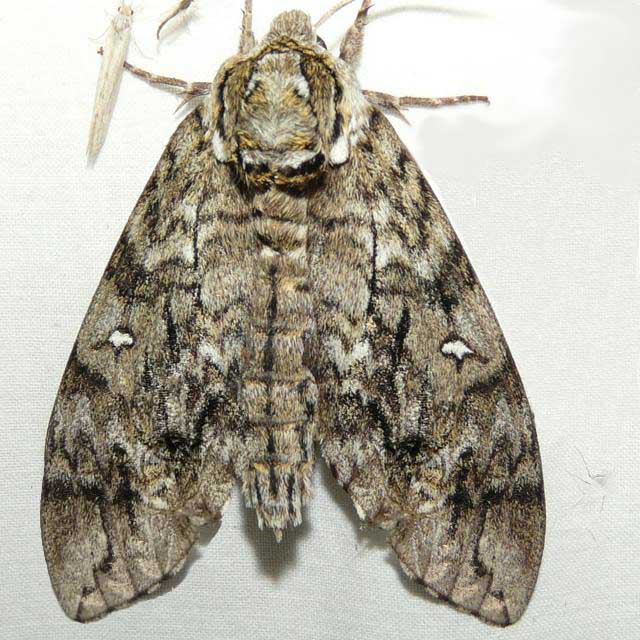Sphinginae subfamily
Sphingini tribe:
 |
Ceratomia amyntor
WO,
the Elm Sphinx or Four-horned Sphinx.
The upperside of the forewing is brown with dark brown and white
markings including a white costal area near the wing base, dark
streaks along the veins, and a white spot in the cell. The upperside
of the hindwing is light brown and has a dark brown band along the
outer margin.
|
 |
The upperside of the forewing is pale brownish gray with wavy black and white lines and a
black-outlined white cell spot. The upperside of the hindwing is gray
with diffuse darker bands.
|
Ceratomia undulosa, Harbor Beach, Huron County, Michigan, July 22, 2010, courtesy of Betsy Higgins.
 |
The upperside of the forewing is gray with heavy black bands. The
upperside of the hindwing is brownish gray with no markings.
If you have pines, you
might have this species. It also flies on P.E.I.
|
 |
Lintneria eremitus
WO,
the Hermit Sphinx.
The upperside of the forewing is gray-brown with wavy lines, black
dashes, and one or two small white spots near the center of the
costa. The upperside of the hindwing is black with two white bands
and a triangular black patch at the base.
Note the golden hair on the thorax.
|
 |
This large bodied moth flies in tobacco fields and vegetable gardens
(potatoes, tomatoes) and wherever host plants are found.
|
 |
The upperside of the forewing has indistinct black, brown, and white
markings.
If you grow tomatoes, you have probably encountered it.
Larvae get very large and can strip a tomato plant.
|

|
Sphinx canadensis
WO,
Sphinx canadensis, the Canadian Sphinx, is not common, and is not often reported anywhere,
but it might possibly be present in Huron County.
Larval hosts are white ash (Fraxinus americana) and blueberry
(Vaccinium).
|
 |
Sphinx chersis
WO,
the Northern Ash
Sphinx or Great Ash Sphinx
The upperside of the forewing is soft dark gray to blue-gray with a series of black dashes,
one of which reaches the wing tip.
|

|
Forewings, long and slender, are held close to the body when the
moth is at rest.
We have them on P.E.I.,
but I do not see them nearly as frequently as I see the other Sphingidae. |
 |
The lower forewings are predominantly brownish-yellow with a fairly
wide dark bar along the inner margin. At rest the wings hug the
body, giving the moth a long slender look.
|
 |
Sphinx luscitiosa
WO,
the Canadian Sphinx or
Clemen's Sphinx.
The upperside of the forewing is yellowish gray in males and pale
gray with a faint yellow tint in females. In both sexes, the dark
border on the outer margin widens as it approaches the inner margin.
|
 |
If you have blueberries in the woods, then you probably have the
Poecila Sphinx. They are pretty widespread throughout Michigan.
|
Smerinthini Tribe:
 |
The adults are also highly variable; sometimes wings of an individual
may be all one color or may have several colors, ranging from pale to
dark brown, and may have a white or pink tinge. Patterns range from
faint to pronounced.
See the file for the female; she is different.
|
 |
Pachysphinx modesta
BAMONA,
the Modest Sphinx or Poplar Sphinx,
This large poplar/willow feeder is reported in Huron County.
They are a heavy bodied species.
|
 |
The outer margin of the forewing is quite wavy. There is a dark cell
spot and a dark oblique line mid wing from the costa almost to the
inner margin. Basic ground colour is pinkish brown. Flight would
be June-July.
|
 |
This small species is probably widespread and common. This species ranges across North America.
The hindwings have a small blue eyespot ringed with black on a yellow background.
|
 |
Smerinthus cerisyi
WO, the Cerisyi's
Sphinx or One-eyed Sphinx, Larvae feed on poplars and willows.
Flight would be from late May-July as a single brood.
|
 |
This moth is widely distributed and fairly common, and it is recorded
in Huron.
Along the East Coast, it flies from P.E.I. to Florida.
|
Macroglossinae subfamily
Dilophonotini Tribe:
 |
Hemaris diffinis
BAMONA,
the Snowberry Clearwing or Bumblebee Moth,
The moth flies along forest edges and in meadows, gardens and
brushy fields. Day-flying adults nectar at lantana, dwarf bush honeysuckle,
snowberry, orange hawkweed, thistles, lilac, Canada violet, etc. |
 |
Hemaris gracilis
BAMONA,
The Slender Clearwing or Graceful
Clearwing. Hemaris gracilis is distinguished from
similar species by a pair of red-brown bands on the sides of the
thorax, which varies from green to yellow-green dorsally and
sometimes brown with white underneath.
They have a red abdomen.
|
 |
Hemaris thysbe
WO,
the Hummingbird Clearwing.
It is not difficult to see why many gardeners would mistake an
Hemaris thysbe moth for a small hummingbird as it hovers,
sipping nectar
from flowers through a long feeding tube.
|
Philampelini Tribe:
 |
Eumorpha achemon
WO,
the Achemon Sphinx.
Adults nectar at Japanese honeysuckle
(Lonicera japonica), petunia (Petunia hybrida), mock
orange (Philadelphus coronarius), and phlox (Phlox).
Larvae feed upon Grape (Vitis), Virginia
Creeper (Parthenocissus quinquefolia) and other vines and
ivies (Ampelopsis).
|
 |
If you have Grape or Virginia Creeper nearby, then you probably have
this species. I often get asked to identify larvae from areas where
they have not previously been reported. |
Macroglossini Tribe:
 |
This day flier is widely distributed. If you have Virginia Creeper,
you probably have the Nessus Sphinx. Two bright, distinct, narrow
yellow bands are often visible on the abdomen.
|
 |
They are common in New Jersey and common
here on Prince Edward Island.
You will often see this species listed as Darapsa pholus,
especially in older literature.
|
 |
Darapsa myron
WO,
the Virginia Creeper Sphinx or the
Grapevine Sphinx
This moth is not recorded on the U.S.G.S. site for Huron County.
It is widely reported in southern Michigan and in southern Ontario.
If you have the foodplants indicated in the common names, you probably have this
species nearby.
|
 |
The upperside is light brown with dark brown markings.
There is a small black and white spot near the tip.
The upperside of the hindwing is orange-brown with a dark brown outer margin and median line.
|
 |
Hyles gallii
WO,
the Bedstraw Hawk Moth
or Gallium Sphinx
This species is not reported in Huron, but it has been recorded in
Michigan counties north and south. I suspect it is present.
Some years I see them on P.E.I., some years, I do not.
|
 |
Hyles lineata
WO,
the White-lined Sphinx
Adults usually fly at dusk, during the night, and at dawn, but they
also fly during the day over a wide variety of open habitats
including deserts, suburbs, and gardens.
|
 |
This moth is very much under reported on USGS. It is a
rapid day flier so is probably not in too many collections.
Grape is a popular larval host.
|
Sphecodina abbottii, May 28, 2007, Filion, Jan Carson.
|
|



